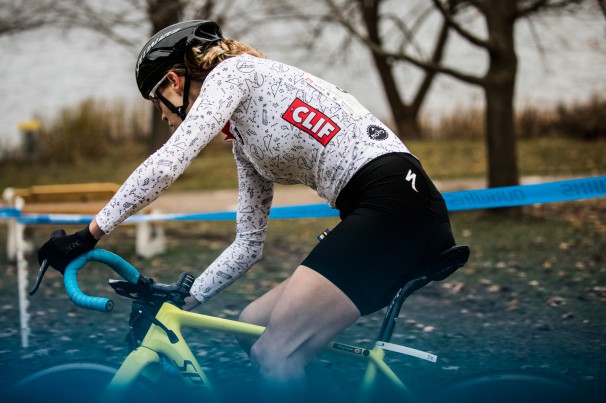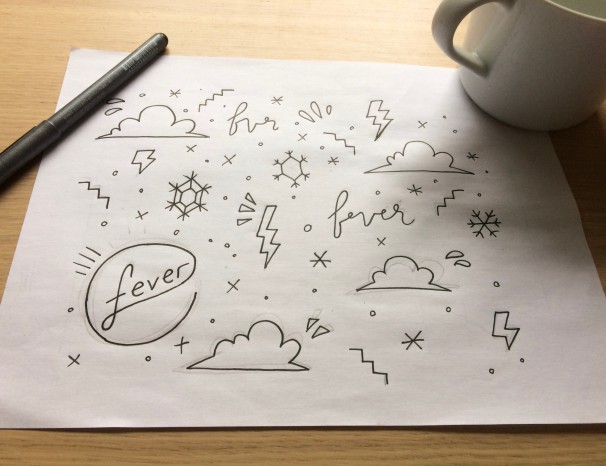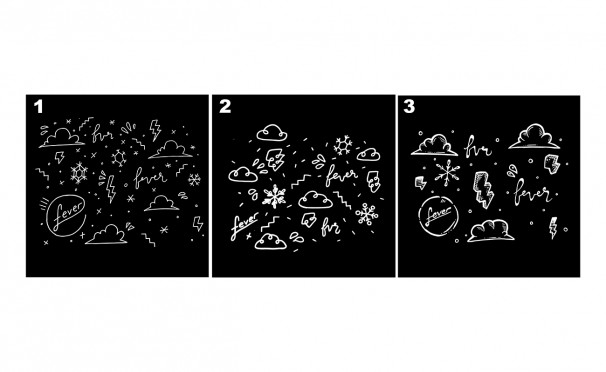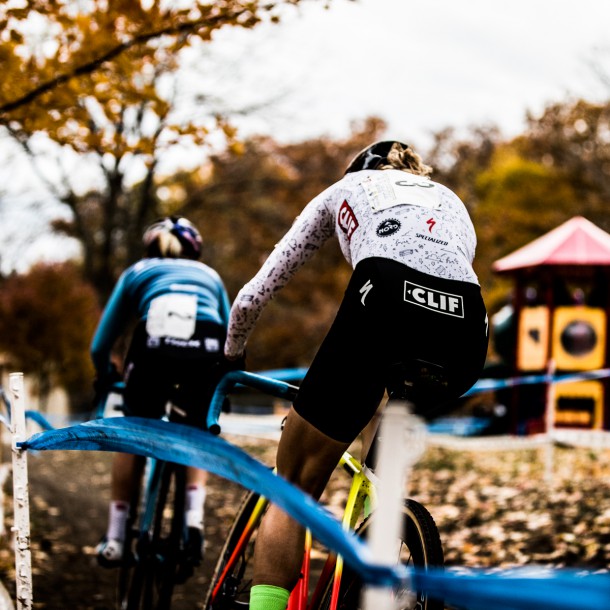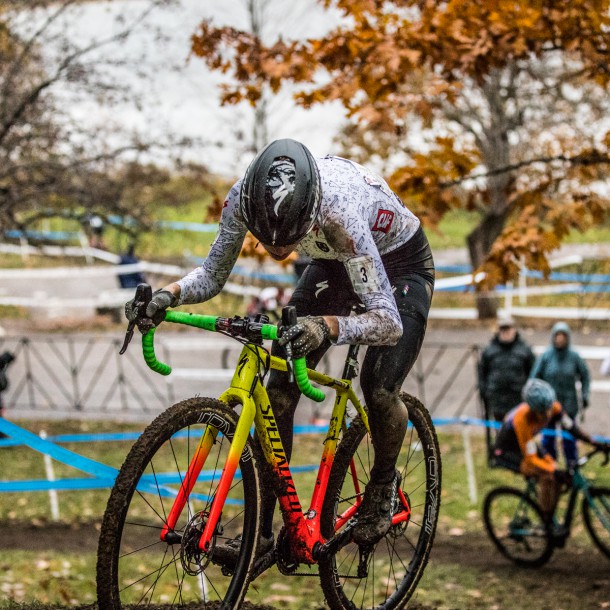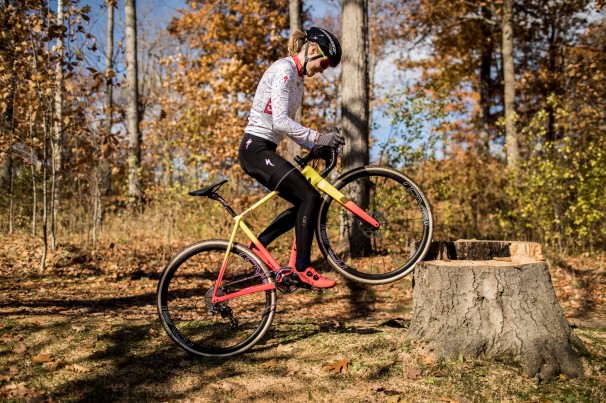Behind the CXFever/TSH kit
By Maghalie Rochette
When we made the decision to start the CXFever team, one of the most exciting things for me was the idea of creating a kit. We had carte blanche. In my mind, initially, I imagined a simple kit. Eccentric shorts…black with a drawn pattern on it, and a simple white jersey with maybe a touch of light blue. The final result is very different from what I originally had in mind, but I love it. It’s my favorite kit I’ve ever owned and it makes me feel good when I put it on. Today, I want to walk you through the process of how the CXFever Kit came to life. How did it change from that vague idea in my mind, to the kit I get to wear at all the biggest races?
It all started with one of my good friends…Alexis Cartier.
Getting to know the designer:
Initially, I didn’t know who would be my clothing partner, so I approached one of my friends and asked him if he wanted to help me design a kit. I thought that if we already had a design, it would be easier to create the kit for the company I would end up working with. The reason I decided to approach Alexis for that project, rather than anyone else, is very simple. Alexis raced professionally on the road for many years, while getting his degree in design. He raced all the biggest North American races, wearing the colors of the H&R Block Pro Cycling team and in his spare time between racing and training, you could often find him drawing. In other words, Alexis knows cycling, he knows me, he is a great illustrator, and he is very creative…I couldn’t think of a better person to design the kit.
Once the kit was completed, I was able to ask Alexis a few questions about how he created the drawings.
Maghalie Rochette
I know this was the first time you designed a cycling kit. What was your first reaction when I asked you to design the kit? Were you nervous, or did you know right away what you wanted to create?
Alexis Cartier
I was very nervous. I did a few small projects in the past, but this was the first project for someone I know and care about. I really didn’t want to disappoint.
Maghalie Rochette
What was your thought process in creating the kit? How do you typically work? Do you start drawing and ideas progressively come to you, or do you have other steps that you follow when creating things like that?
Alexis Cartier
The biggest part is to choose which direction to explore. That first step takes place solely in my head, but usually still takes a while. Once I have a good idea, I sit down and get to work. I start by drawing random things to warm up my hand and my mind. Then I explore my ideas with different styles. Quite often, new ideas come just by drawing and I go back to the first thinking step. The last step is to actually make it into a real sized kit and is more technical than creative. Your feedback at every step was also very important. What I like is not necessarily what you like.
Maghalie Rochette
I really love the drawings you did that are now the main pattern of the kit. What was your inspiration behind this CXFever themed drawing?
Alexis Cartier
You told me you wanted some kind of drawings, but you did not have a specific topic. I did not want to pick up something arbitrary, and although it took me a while to come up with the idea, the CXFever was an obvious choice. It also offers great graphic possibilities. Stairs, barriers, clouds, snowflakes and lightning bolts are visually interesting and easily recognizable.
Maghalie Rochette
What was the most challenging thing about designing a kit?
Alexis Cartier
Right at the beginning, you told me you did not want something girly. You wanted a design that would be gender neutral, maybe slightly feminine. To achieve that subtlety was the biggest challenge.
I think the delicate weight of the drawings gives the perfect feminine touch.
Maghalie Rochette
When we brought the design to TSH, the final design changed a little bit from what it was originally. Are you happy with how the final design turned out?
Alexis Cartier
I am definitely happy. I find it important to have somebody from outside to critic a design, and TSH have great taste. There were also technical printing limitations that I wasn’t aware of.
Maghalie Rochette
Would you do it again, designing clothing or cycling kits?
Alexis Cartier
Yes, anytime. I think cycling culture is getting less and less conservative and that allows great creative possibilities. Also, seeing my design at the front of a World Cup race is not a bad feeling.
…
Bringing the idea to TSH and creating the final version:
Once Alexis had done the first design of the kit, I talked to Luke from Tenspeed Hero to see if they would like to work together. Luke had already been in touch with me as soon as he heard I was starting a new program, but I had to confirm a few things before we could officially start working together. The truth is I really wanted to work with TSH, because I love how they do things. We’ve done projects in the past and those were always amazing experiences for me. At TSH, they are great people, they make beautiful and comfortable clothes, they are artists and business people, and I constantly feel inspired and stimulated when I spend time with them. It was a no brainer! Recently, I asked Luke (TSH co-founder, photographer, artist) how the kit went from a sketch, to the actual kit I am wearing…
Maghalie Rochette
What was your first thought when I came to you with the first sketches of the kit?
Luke Batten
I’ve actually always been into the idea of small drawings and sketches and I’ve wanted to do something hand drawn. Even though we’ve dealt with patterns and illustrators before, I always wanted the feel of a sketch, so immediately, I was interested.
Maghalie Rochette
If I’m right, I think that at TSH, you normally start from scratch when creating a design…Even when working with different emerging designers, I imagine each creation starts as a conversation between the two of you. This time, there was already a sketch made by my friend Alexis (who you had never met before!). Was that challenging for you to start working with something that was already made rather than starting from scratch directly with the designer?
Luke Batten
Definitely. It gave me pause, in a sense that I had to make a quick decision. With our typical process, the idea is very loose, very abstract…I’ll have an idea and I’ll talk to a designer about it, and then they’ll have to process it and start working. It’s rare to get a design and visualization already done and it’s not typically the way we work.
Maghalie Rochette
One of the things you told me, initially, was that the top was missing a little something. You talked to me about “having a 3D vision” when designing a kit, about the space that a piece takes in real life when following an athlete’s movements. Can you explain a little bit what you meant by that and how those thoughts affect how you design clothing?
Luke Batten
It’s really weird because when you are laying out a jersey, it is very two dimensional. But you have to try to imagine it around a body… We’ve made some pretty complex pattern where once the illustration is wrapped around a body, suddenly there are new shapes and things that we just never expected! Especially with the more complex designs. With this drawing, I thought it should move from the shorts to the top, my desire, but also my worry, was readability. We knew we wanted to put it on white, we knew that these lines were noticeable, but they weren’t big “words” or traditional logos so I think it was important for me that we could feel and see the essence of the design. It’s always a gamble.
Maghalie Rochette
Similarly, what are some of the key things you think about when designing a piece?
Luke Batten
I think about the design, but I also think about the photography. Being a photographer at my core I want to make sure that when we document you during races, we capture the design and the idea that you and Alexis were trying to illustrate. The thing is we don’t even know that it will work until you are actually out there racing! I’ve been really happy to see all the little things (the snowflakes, barriers, etc), that they really do come to life, and with the right photo, they pop up.
Maghalie Rochette
TENSPEED HERO is all about finding beauty in simplicity. Being minimalist with logos and just creating beautiful, simple designs. On the CXFever kit, we had to put logos, but I find the way you introduced them on the kit feels very natural. Was it a challenge for you to have to introduce logos in a design? And how did you make it look so natural?
Luke Batten
You know, I’m of two minds… I think that the logos and the brands, it’s part of professional racing and I think you can have a lot of fun with it. Sometimes I even enjoy the Italian Continental team’s jerseys that have 50 logos on it, because it’s so absurd and there is so much “noise”. But that’s kind of part of the sport…cobbling together all these people that want to support an athlete or a team. It’s fun to integrate the sponsor logos with a broader concept thereby creating a more direct connection to the athlete. And that’s what I love about our designs. Whether it’s Sprinkles, which kind of expresses a certain amount of joy, or whether it’s really good color blocking like we did with the Bitchstix team. They allow the corporate identity and the individual racer’s identity to coexist in a complementary way.
The thing I love about you is that you are passionate for the sport, your affection for all the little aspects is literally illustrated on the jersey. So when you asked me how did I take this pattern to create the kit, I said I took pause because I really had to stop and think about it for a few days. I have to do that with any design choice. Once I understood the drawings and the pattern on my own terms, then I could go back to you and say YES this is great!! It’s wonderful. It’s so you! And so I had a lot of confidence. It was also important to me to make clothes that you are happy in. Because happy athletes are successful athletes.
Maghalie Rochette
At first, I remember we were hesitating between a black or a white kit. I remember you being excited about a white kit for cyclocross. Why was that?
Luke Batten
Cyclocross, of all cycling disciplines, is raced in the most awful weather. Normally you see a white kit, you think light, you think summer or spring. But I think it’s kind of bold to have it for cyclocross. And I think it’s amazing when the course gets on the jersey and you can see it everywhere. You can see the mud that has flicked up from another athlete, and you can see that a crash has happened. It shows you how difficult this sport is, but also how fun it is. You know, there is something about being a little kid and getting dirty. Imagine someone in a white dress and jumping in a puddle of water…there is a joy in that.
Maghalie Rochette
That’s more a general question, but I’m curious. When you finish a piece or a collection, do you find yourself always thinking about what you could have done differently, or are you generally pretty satisfied when you see the final product in action?
Luke Batten
It’s something I think about all the time, even when the collection is done and sold, I still go back and reflect on why did I make the decisions I made and how I could be better at that. Obviously there are individual pieces but there is also a larger structure, a collection. Like our Resort collection where not only were we trying to make a statement with an individual piece, but also have a larger mood. Typically, when you are coming out with a collection, you might be generating 12-13 ideas, yet you know the collection is only going to be 3-4 pieces. That decision making process is really difficult. I like to think that when someone is buying an individual garment, that piece still reflects the mood and emotion of the entire collection. That kind of thinking is very typical in fashion design, probably not as much in cycling designs. When I make those decisions I have this in mind. I might take a guess and it might be more successful it might not. The success of a collection is not only how we feel about it, but also whether costumers feel positive about it and to be honest, if they buy it or not. It’s a constant struggle and even though we work a year or year and a half out, it can be a last minute emotional decision to say: “okay this is piece we need to make!”
Maghalie Rochette
Final question: A lot of people have the Fever, and many have asked if they could get their own CXFever Kit? What should we tell these feverish people? Will they be able have their own CXFever/TSH piece eventually?
Luke Batten
Yes they will! We really want to honor and thank everyone that has a relationship with us via cyclocross. We are going to put out a very small capsule of some of our favorite pieces and new colorways in late January.
At that time, the Fever will be through the roof because the World Championships will be just around the corner. And we’ve never done it this way, but what’s going to be fun is that people will have been able to follow the successes, the ups, the downs, the courses and the memories all season. I think what’s nice is that people will be able to buy a piece and reflect on what you’ve been through throughout the season and carry that through the spring.
